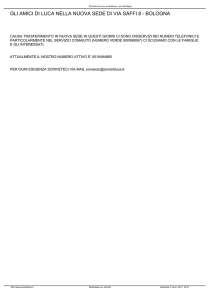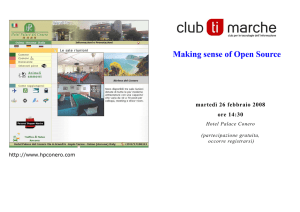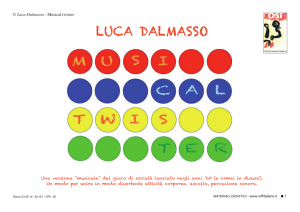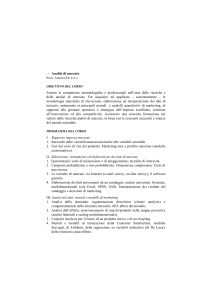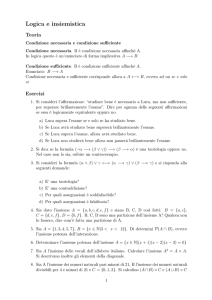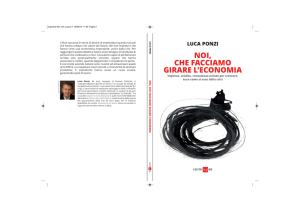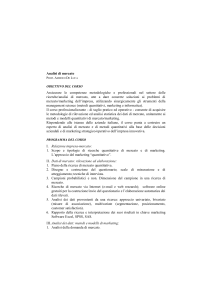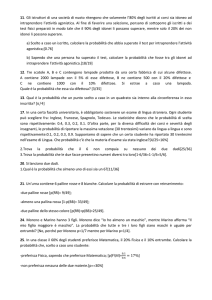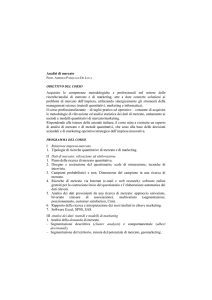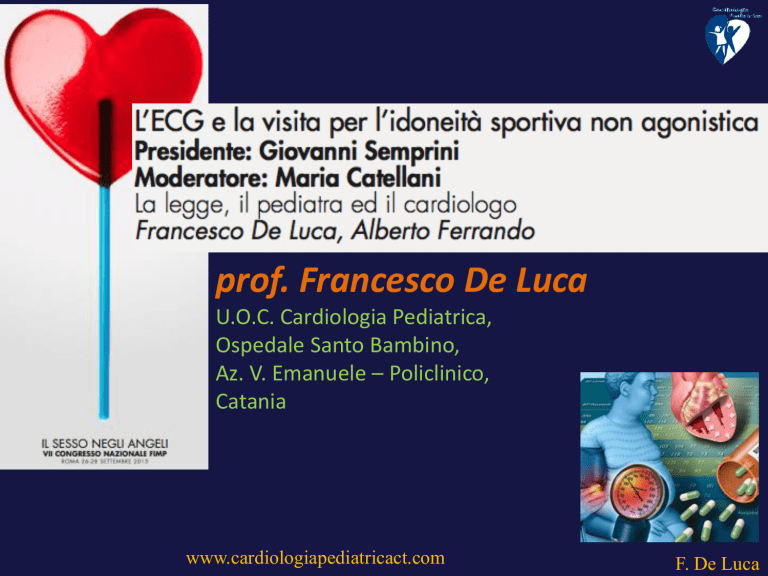
prof. Francesco De Luca
U.O.C. Cardiologia Pediatrica,
Ospedale Santo Bambino,
Az. V. Emanuele – Policlinico,
Catania
www.cardiologiapediatricact.com
F. De Luca
Al mio segnale scatenate l’inferno…
Alberto Ferrando
www.cardiologiapediatricact.com
F. De Luca
Pulse oximetry screening for congenital heart
defects in newborn infants (PulseOx):
a test accuracy study
Background: Screening for congenital heart defects relies on antenatal
ultrasonography and postnatal clinical examination; however, lifethreatening defects often are not detected. We prospectively assessed the
accuracy of pulse oximetry as a screening test for congenital heart defects.
Methods In six maternity units in the UK, asymptomatic newborn babies
(gestation >34 weeks) were screened with pulse oximetry before discharge.
Infants who did not achieve predetermined oxygen saturation thresholds
underwent echocardiography. All other infants were followed up to 12
months of age by use of regional and national registries and clinical followup. The main outcome was the sensitivity and specificity of pulse oximetry
for detection of critical congenital heart defects (causing death or requiring
invasive intervention before 28 days) or major congenital heart disease
(causing death or requiring invasive intervention within 12 months of age).
Lancet 5 August
2011
www.cardiologiapediatricact.com
F. De Luca
Conclusions: Pulse oximetry is a safe, non-invasive, feasible, and accurate
test, which has a sensitivity that is better than that of antenatal screening
and clinical examination. The use of both, preductal and postductal
saturations, compared with postductal saturation alone seems to be
advantageous and in practice does not take much longer to do. It adds value
to existing screening procedures and is likely to be useful for identification of
cases of CCHD that would otherwise go undetected. The results of this
study enhance the strong evidence that indicates the potential benefits of
the introduction of predischarge pulse oximetry screening as a routine
www.cardiologiapediatricact.com
procedure.
F. De Luca
Vantaggi dello screening della
saturazione:
Costo molto basso
Nessun rischio
Ottima specificità (0,03% di falsi positivi)
Buona sensibilità (ma variabile a secondo del
tipo di cardiopatia)
Ma in Italia, sebbene sia raccomandato dalla
AAP, sono ancora centinaia i punti nascita in
cui non viene eseguita come i PDF ben sanno…..
www.cardiologiapediatricact.com
F. De Luca
www.cardiologiapediatricact.com
F. De Luca
Vigor Bovolenta
www.cardiologiapediatricact.com
F. De Luca
www.cardiologiapediatricact.com
F. De Luca
www.cardiologiapediatricact.com
F. De Luca
Morte cardiaca improvvisa. Ogni anno
muoiono mille giovani
•
03 MAR - Sono giovani e apparentemente sani. Eppure muoiono per morte cardiaca
improvvisa. Un evento drammatico che colpisce ogni anno oltre mille under 35, ed otto donne
su 100mila tra i 30 ed i 45 anni. Una morte causata da difetti congeniti e malattie genetiche che
potrebbero essere scoperti con un semplice Ecg. Per questo dal 7 al 13 marzo parte la campagna
“Ascolta il battito. Un ECG può salvare la vita” promossa dalla Società Italiana
di Cardiologia (Sic) e dalla Fondazione Italiana Cuore e Circolazione-Onlus
con il patrocinio del Miur. La campagna che ha ricevuto il via libera dal
Segretariato sociale Rai nell’ambito di trasmissioni televisive e radiofoniche
Rai, punta a raccogliere fondi con sms solidali. Obiettivo: realizzare il progetto “A
scuola di cuore” che attraverso screening cardiovascolari ed Ecg agli studenti tra i 16 e i 18 anni
delle scuole secondarie, punta a individuare i soggetti a rischio e a confermare la diagnosi anche
con test genetici. Gli screening dovrebbero partire nelle scuole di Lombardia, Piemonte, Lazio.
www.cardiologiapediatricact.com
F. De Luca
Comunicato stampa Roma, 8 aprile 2013
Morte “improvvisa” giovanile: lo screening
elettrocardiografico può salvare la vita
Iniziativa nelle scuole del territorio dell’Ospedale Pediatrico Bambino
Gesù di Palidoro con il Comune di Santa Marinella
Viene chiamata “morte improvvisa” in età pediatrica, perché colpisce
bambini apparentemente sani: circa 5 pazienti all’anno su 100.000, dicono i
dati. Si manifesta nel 10-15% dei casi durante l’attività fisica, e nel 90% dei
casi è riconducibile a cause cardiache che potrebbero essere individuate
preventivamente attraverso un semplice elettrocardiogramma.
www.cardiologiapediatricact.com
F. De Luca
www.cardiologiapediatricact.com
F. De Luca
• Lunedì 22 Aprile 2013 - Parte
a Marsala il progetto
contro la morte "improvvisa" giovanile
www.cardiologiapediatricact.com
F. De Luca
www.cardiologiapediatricact.com
F. De Luca
www.cardiologiapediatricact.com
F. De Luca
Le dimensioni del fenomeno
SCD in bambini e
adolescenti
SCD in pazienti con
cardiopatia congenita
0,6-6,2/100.000/anno
(il 25° dei casi avviene durante lo
sport. Nel giovane atleta il rischio
é x 2,5 durante l’attività sportiva)
100/100.000 pazienti
SCD in età adulta
www.cardiologiapediatricact.com
135/100.000
F. De Luca
What causes SCD?
Distribution of
cardiovascular
causes of
sudden death I
in 1435 young
competitive
athletes
Maron BJ et al. Circ. 2007
www.cardiologiapediatricact.com
F. De Luca
Two approaches to screening
• Focused history and physical exam, further workup only if risk-factors identified (U.S. approach)
• H&P, plus ECG, with further work-up if
abnormalities on either (Italian approach)
www.cardiologiapediatricact.com
F. De Luca
The Italian experience
• Pioneers of ECG screening for athletes
• They provide annual ECGs for all athletes
ages 12-35
• They report dramatic reduction in SCD
www.cardiologiapediatricact.com
F. De Luca
SCD rate in athletes and non-athletes,
Veneto, Italy, 1979-2004
Corrado D. JAMA. 2006.
www.cardiologiapediatricact.com
F. De Luca
What about the USA?
• Maron et al compared SCD death rates in
Minnesota with those reported in Veneto
• They found that, without ECG screening,
SCD rates in MN were comparable to
those in Italy with ECG screening
www.cardiologiapediatricact.com
F. De Luca
Veneto and Minnesota comparable
in population and ethnicity
www.cardiologiapediatricact.com
Maron et al. Am J Card. 2009
F. De Luca
Trends in rates of SCD in MN and Veneto, 1979-2004
Since 1995, there has been no
statistical difference in SCD
Maron et al. Am J Card. 2009.
www.cardiologiapediatricact.com
F. De Luca
To save one life…
• About 1,700 athletes would have
to be prohibited from sports, and
their families warned that sudden
cardiac death could kill their child
www.cardiologiapediatricact.com
Bessem et al. Br J Sports Med. 2009.
F. De Luca
Difficulties with screening
Many false positives and false negatives
•
•
•
•
– Cannot prevent all deaths
– Prevents sports participation in many
people at low risk of SCD
Anxiety for athletes with positive screen
Cost
Demands on medical personnel
Freedom vs. paternalism
www.cardiologiapediatricact.com
F. De Luca
So what is a pediatrician to do?
• AHA recommends H&P, without routine
ECG
• Present parents the facts
• Acknowledge uncertainty
• Ultimately, must be a shared, wellinformed, and individualized decision
www.cardiologiapediatricact.com
F. De Luca
Is SCD preventable?
• The $2 billion question!
• Some conditions that predispose to SCD
can be picked up on sports screening,
others cannot
• Screening programs are expensive
• Experts advocate different approaches
www.cardiologiapediatricact.com
F. De Luca
Circulation 2007, 116
www.cardiologiapediatricact.com
F. De Luca
Circulation 2007, 116
www.cardiologiapediatricact.com
F. De Luca
www.cardiologiapediatricact.com
F. De Luca
Segni e sintomi di allarme
• Benché un SCD può essere il primo sintomo
di presentazione, spesso i pazienti a rischio
per alterazioni funzionali o strutturali o
per disordini elettrici primitivi manifestano
sintomi premonitori.
• La presenza di famigliarità per SCD e i
sintomi sono utili per identificare i
soggetti a rischio e impostare una
prevenzione.
www.cardiologiapediatricact.com
F. De Luca
Segni e sintomi di allarme
Scand Cardiovasc J 2005;39(3):143-149
Studio su 162 casi (15-34 anni) con SCA autopsia neg:
IL 50% aveva storia di :
•Sincope
•Pre-sincope
•Dolore precordiale
•Palpitazioni
•Dispnea
•Il 16% aveva una storia famigliare di SCD
www.cardiologiapediatricact.com
F. De Luca
Questionario anamnestico suggerito
per attività sportiva da parte della AAP 2010
1. Sei mai svenuto o sei mai stato sul punto di svenire DURANTE o DOPO l’esercizio fisico?
2. Hai mai avuto disturbi (es dolori, crampi o senso di costrizione) al torace durante sforzo fisico?
3. Hai mai avvertito battiti irregolari (tachicardia improvvisa o battiti extra o mancanza di battito)
durante esercizio fisico?
4. In qualche visita precedente qualche dottore ti ha mai detto che potresti avere qualche problema al
cuore? (Pressione alta, colesterolo alto, soffi al cuore, infezione al cuore, malattia di Kawasaki?)
5. Qualche medico ti ha mai prescritto esami per il cuore? (es ECG di base e/o sotto sforzo, eco etc.?)
6. Ti sei mai sentito stordito o avvertito respiro inaspettatamente corto durante esercizio (più
dell’atteso per lo sforzo)?
7. Hai mai avuto convulsioni non spiegate dai medici?
8. Ti senti più stanco e avverti respiro corto più facilmente dei tuoi amici durante esercizio fisico?
9. C’è qualche parente deceduto prima dei 50 anni per problemi cardiaci accertati oppure per morte
improvvisa non spiegata (includendo annegamenti, incidenti d’auto inspiegati, SIDS)?
10. Qualcuno in famiglia è affetto da: Cardiomiopatia Ipertrofica? Sindrome di Marfan?
Cardiomiopatia Aritmogena del Ventricolo Destro? Sindrome del QT lungo? Sindorme del QT
corto? Sindrome di Brugada? Tachicardia Ventricolare Polimorfa Catecolaminergica?
11. Qualcuno nella tua famiglia ha avuto problemi di cuore, impianto di Pace Maker o Defibrillatore
cardiaco?
12. Qualcuno in famiglia ha avuto inspiegati svenimenti, non spiegate convulsioni, o è stato sul punto
di annegare?
www.cardiologiapediatricact.com
F. De Luca
www.cardiologiapediatricact.com
F. De Luca
Choosing Wisely is focused on
encouraging physicians, patients and
other health care stakeholders to think
and talk about medical tests and
procedures that may be unnecessary,
and in some instances can cause harm.
www.cardiologiapediatricact.com
F. De Luca
www.cardiologiapediatricact.com
F. De Luca
“Sufficient
data
are
lacking
to
support
general
preparticipation screening with history, physical exam,
and ECG in competitive children. Nevertheless, the
impact of such a program, together with secondary
preventive measures, should be evaluated in large
prospective studies”.
www.cardiologiapediatricact.com
F. De Luca
www.cardiologiapediatricact.com
F. De Luca
www.cardiologiapediatricact.com
F. De Luca
www.cardiologiapediatricact.com
F. De Luca
www.cardiologiapediatricact.com
F. De Luca
www.cardiologiapediatricact.com
F. De Luca
www.cardiologiapediatricact.com
F. De Luca
www.cardiologiapediatricact.com
F. De Luca
www.cardiologiapediatricact.com
F. De Luca
De sexu angelorum?
www.cardiologiapediatricact.com
F. De Luca
www.cardiologiapediatricact.com
F. De Luca
www.cardiologiapediatricact.com
F. De Luca
www.cardiologiapediatricact.com
F. De Luca
www.cardiologiapediatricact.com
F. De Luca
www.cardiologiapediatricact.com
F. De Luca
www.cardiologiapediatricact.com
F. De Luca
Pre-participation
ECG
screening
of
athletes
is
controversial.
Pediatric
electrophysiologists (Eps)do not interpret screening ECGs more accurately than
pediatric cardiologists with average number of correct ECG interpretations of 13.112.4 (P = .14). Our study demonstrates that an accurate interpretation of sECGs for
athletes is difficult even for pediatric EPs, who receive the most training in
interpreting ECGs. The difficulty lies in the challenge of distinguishing various
morphologies based on ECG alone without clinical information and among a group
of predominantly healthy, normal ECGs. As the debate regarding the role of ECGs in
screening athletes continues, attention should be given to the question of who will
be able to most accurately read the ECGs and how best to train them.”
www.cardiologiapediatricact.com
F. De Luca
Mandatory Electrocardiographic Screening of
Athletes to Reduce Their Risk for Sudden Death
Proven Fact or Wishful Thinking?
• Objectives The purpose of this study was to determine if pre-participation
screening of athletes with a strategy including resting and exercise
electrocardiography (ECG) reduces their risk for sudden death.
• Results There were 24 documented events of sudden death or cardiac
arrest events among competitive athletes during the years 1985 through
2009. Eleven occurred before the 1997 legislation and 13 occurred after it.
The average yearly incidence of sudden death or cardiac arrest events was
2.6 events per 100,000 athlete-years. The respective averaged yearly
incidence during the decade before and the decade after the 1997
legislation was 2.54 and 2.66 events per 100,000 person years, respectively
• Conclusions The incidence of sudden death of athletes in
our study is within the range reported by others. However,
mandatory ECG screening of athletes had no apparent
effect on their risk for cardiac arrest.
(J Am Coll Cardiol 2011)
www.cardiologiapediatricact.com
F. De Luca
www.cardiologiapediatricact.com
F. De Luca
www.cardiologiapediatricact.com
F. De Luca
www.cardiologiapediatricact.com
F. De Luca
Driver dell’overdiagnosis
• Evoluzione delle tecnologie diagnostiche che consentono di
identificare “anomalie” anche minime
• Interessi commerciali e professionali (lobbies)
• Gruppi di esperti in palese conflitto di interessi che espandono
continuamente le definizioni di malattia e definiscono nuove entità
patologiche
• Orientamento dell’autorità giudiziaria a condannare
l’underdiagnosis, ma non l’overdiagnosis
• Sistemi sanitari che incentivano la medicalizzazione
• Percezione socio-culturale che “more is better” e che la diagnosi
precoce non comporta alcun rischio
www.cardiologiapediatricact.com
F. De Luca
• E’ possibile giungere ad
una sintesi???
www.cardiologiapediatricact.com
F. De Luca
Circulation. 2012
…Conclusion
www.cardiologiapediatricact.com
F. De Luca
Grazie Prof.
www.cardiologiapediatricact.com
F. De Luca
Grazie per l’attenzione!!!
www.cardiologiapediatricact.com
F. De Luca

